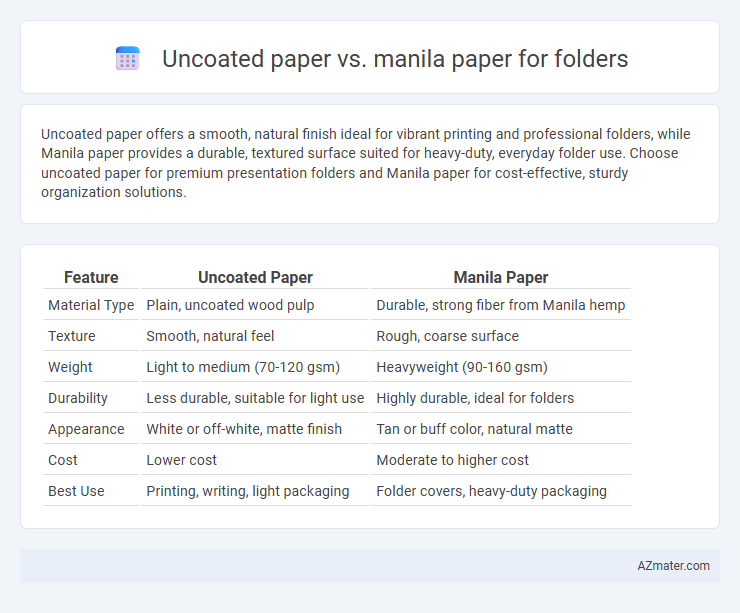Uncoated paper offers a smooth, natural finish ideal for vibrant printing and professional folders, while Manila paper provides a durable, textured surface suited for heavy-duty, everyday folder use. Choose uncoated paper for premium presentation folders and Manila paper for cost-effective, sturdy organization solutions.
Table of Comparison
| Feature | Uncoated Paper | Manila Paper |
|---|---|---|
| Material Type | Plain, uncoated wood pulp | Durable, strong fiber from Manila hemp |
| Texture | Smooth, natural feel | Rough, coarse surface |
| Weight | Light to medium (70-120 gsm) | Heavyweight (90-160 gsm) |
| Durability | Less durable, suitable for light use | Highly durable, ideal for folders |
| Appearance | White or off-white, matte finish | Tan or buff color, natural matte |
| Cost | Lower cost | Moderate to higher cost |
| Best Use | Printing, writing, light packaging | Folder covers, heavy-duty packaging |
Introduction to Folder Paper Choices
Uncoated paper and Manila paper offer distinct advantages for folder manufacturing, with uncoated paper providing a smooth, writable surface ideal for customization and high-quality printing. Manila paper is known for its durability and resistance to wear, making it a practical choice for folders that require sturdiness and a classic appearance. Both materials vary in weight and texture, influencing the folder's feel, strength, and overall functionality.
What is Uncoated Paper?
Uncoated paper is a type of paper that lacks a surface coating, resulting in a natural, porous texture ideal for writing and printing. Compared to Manila paper, uncoated paper offers a smoother finish and superior ink absorption, making it suitable for high-quality folders requiring clear text and vibrant colors. Its versatile applications include notebooks, flyers, and folders where a professional appearance without gloss is desired.
What is Manila Paper?
Manila paper is a type of sturdy, unbleached kraft paper traditionally made from Manila hemp fibers, offering high durability and resistance to tearing. It features a natural light brown color and a rough texture, making it ideal for folders that require strength and long-lasting protection. Compared to uncoated paper, Manila paper provides enhanced rigidity and moisture resistance, ensuring better file preservation and handling.
Key Differences Between Uncoated and Manila Paper
Uncoated paper offers a smooth texture with a natural finish, ideal for high-quality printing and writing, while Manila paper is thicker, more durable, and has a distinct tan color suited for heavy-duty folders and envelopes. The primary difference lies in weight and texture: uncoated paper is lighter and more porous, allowing better ink absorption, whereas Manila paper is heavier, with a stiff, rough surface that resists tearing. For folder production, uncoated paper provides a refined look and is better for detailed printing, whereas Manila paper ensures structural integrity and longevity.
Durability Comparison for Folder Use
Uncoated paper offers moderate durability for folder use but is more prone to tearing and moisture damage compared to Manila paper, which is known for its enhanced strength and resistance. Manila paper's robust fibers and thicker texture provide superior durability, making it ideal for folders that experience frequent handling or require long-term storage. When selecting materials for folders, choosing Manila paper ensures better protection and longevity due to its sturdier composition.
Printability and Writeability
Uncoated paper offers superior writeability due to its porous texture, allowing ink to absorb quickly without smudging, making it ideal for handwritten notes on folders. Manila paper, while slightly stiffer and rougher, provides moderate printability with less ink absorption, resulting in crisper printed images but less smooth writing experience. For applications requiring enhanced print clarity and moderate writeability, manila paper suits folder production, whereas uncoated paper excels when legible handwriting is prioritized.
Aesthetic and Texture Considerations
Uncoated paper offers a smooth, natural finish that enhances print clarity and provides a subtle, refined aesthetic ideal for professional folders. Manila paper features a coarse, fibrous texture with a distinctive warm beige tone, delivering a rustic and vintage look that appeals to eco-conscious or artistic designs. The choice between the two depends on whether a sleek, polished appearance or a tactile, organic feel is desired for folder presentation.
Cost Effectiveness and Availability
Uncoated paper is generally more cost-effective than Manila paper, making it a preferred choice for budget-sensitive folder production. Its widespread availability across various suppliers ensures consistent procurement without delays, whereas Manila paper, often thicker and more specialized, can be pricier and less readily stocked. Businesses prioritizing economical and accessible materials typically opt for uncoated paper to balance quality with affordability and supply reliability.
Environmental Impact: Sustainability Factors
Uncoated paper offers a lower environmental impact due to its minimal processing, reducing chemical use and energy consumption compared to Manila paper, which often involves bleaching and dyeing processes. Manila paper, typically made from abaca fibers, supports sustainability by utilizing renewable resources but may involve higher water usage in production. Choosing uncoated paper for folders supports eco-friendly practices by enhancing recyclability and biodegradability, aligning with sustainable office supply standards.
Choosing the Best Paper for Your Folder Needs
Uncoated paper offers a smooth, natural finish ideal for printing folders that require vibrant color reproduction and easy writing, while manila paper provides superior durability and a distinctive buff color, making it perfect for heavy-duty folders needing strength and longevity. Choosing the best paper depends on your folder's purpose: select uncoated paper for professional presentations and detailed graphics, or manila paper for archival storage and frequent handling. Consider factors like thickness, weight, and intended use to ensure the folder meets functionality and aesthetic preferences.

Infographic: Uncoated paper vs Manila paper for Folder
 azmater.com
azmater.com